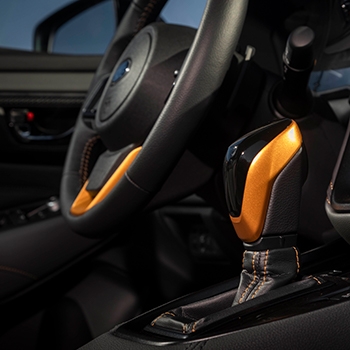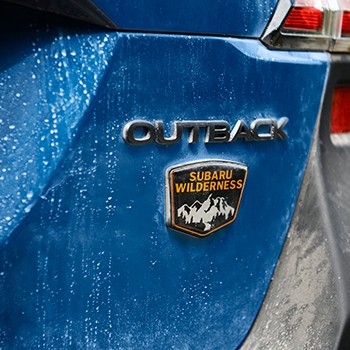A dedicated segment of Outback owners are happiest tackling terrain that most drivers do their best to avoid entirely. That terrain is exactly what’s ahead of me and the new Outback Wilderness™ at Monticello Motor Club’s off-road course in the Catskill Mountains: fast corners on the asphalt and heart-pounding descents into rivers. Outback owners are about to get exactly what they’ve been asking for.

The Outback Wilderness owes its heritage to the original Outback that debuted in 1994 and, even more, to a question asked at Subaru HQ: “Why do Travis Pastrana and Ken Block get to have all the fun? Where’s the fun for our SUVs?” Subaru has STI for performance vehicles; the Outback Wilderness is the first representative of a new family of adventure vehicles from Subaru.
Outback Wilderness on the Road
Every other Outback trim has substantial ground clearance at 8.7 inches. The Outback Wilderness arrives with a remarkable 9.5 inches of ground clearance, thanks to taller coil springs and struts with higher damping rates.
What’s it feel like on the road, hooning around corners and attacking off-ramps on the way to the woods? Something this tall should not bite into a corner this well. Even more surprising, with its taller springs, modified damping and more sidewall in the tires, it feels much smoother and more comfortable than competitive crossovers.



The roads in the Catskills are a mix of fast sweepers with billiard table-smooth asphalt and sections of pavement that have endured 80 years of plow blades and road salt. The Outback Wilderness eats it, unperturbed by how rough it gets.
Outback Wilderness off the Road
Nobody is buying an Outback to attack the Rubicon Trail in the Sierra Nevada. There are other vehicles for that. “People are looking for an ‘Outback Plus,’” says Nikkie Riedel, Carline Planning Manager for the Outback at Subaru of America, Inc. “It has to do everything. They’re Subaru owners – safety and security as well as fun, freedom, confidence and control are all paramount.”

The Outback Wilderness fights way out of its weight class with numbers that rival body-on-frame SUVs with legendary off-road credibility as well as full-size pickups based on race trucks.
Along with the tall ground clearance, the Outback Wilderness is designed to clear obstacles on the way up or down a steep incline. Both the front and rear bumpers are reshaped to provide as much approach and departure angle as possible while still retaining the award-winning crash structure underneath.
Off-road, in just a couple of turns, the trail turned hairy. Through a section of trees, we encountered a rocky, slick decline about 30 feet long and alarmingly steep.
Thanks to the ground clearance in the Outback Wilderness, you have the breakover angle to make that drop without squashing the rocker panels and leaving your exhaust system behind.
Technology is working just as hard as design and engineering in this vehicle. Hill Descent Control (HDC) works like cruise control for off-road situations, allowing the driver to concentrate on steering rather than brake or throttle inputs. The decline was steep enough that we were hanging from the pretensioners on the seat belts. Dropping down the hill, HDC hummed and buzzed as the system braked individual wheels and slowly took us down to the bottom.
Flat ground on the bottom is another challenge, though. Without enough approach angle, you’d nosedive straight into the bottom, the trail claiming your bumper cover. With 20.0 degrees of approach in the Outback Wilderness, we settled out on flat terrain without the body touching ground.
Water Crossing in the Outback Wilderness
The next obstacle was an eye-opener. It was another drop as steep as the last, but shorter. It bottomed out in a creek, where a full-lock right turn put us on an eighth of a mile section of rushing, coffee-colored water up to the bottom of the doors with a rocky riverbed underneath.
Dual-function X-MODE® was the key to success. Using the Deep Snow/Mud function, the system allows more wheelspin than traction control would normally afford. With the wheels spinning, discharging mud and rocks from the tires, you can maintain forward momentum, whereas traction control would leave a vehicle dead in the water. Sloshing through the creek, the Subaru Wilderness scrabbled up the muddy embankment and we were on our way.

The next descent was as steep as the first one, but it terminated in an immediate climb up what looked like a stone wall at the bottom. Our spotter had us turn off the Pre-collision Braking System, which is accessible only when dual-function X-MODE is engaged.
“If you don’t, the system’s going to think you’re crashing into that wall,” he says, before sending us down the decline with a hearty “Good luck!” Hill Descent Control again kept the speed consistent and manageable. When we got to the bottom, a steady throttle churned up the slick rock face in front of us.
There are more aggressive tires than the Yokohama® Geolandar® all-terrain G015s that come standard on the Outback Wilderness, but they tend to howl on the road and put a serious damper on fuel economy. The Geolandars are a great alternative, providing excellent bite and low noise on the road, with a surprising amount of grip in the corners on paved sections.
Getting the torque from the turbocharged 260-hp SUBARU BOXER® engine to the ground also required updates. The transmission has a pressure sensor to distribute torque more evenly that helps navigate more difficult uphill terrain. The final drive ratio is higher, and so is the transfer gear ratio, the two conspiring to provide better throttle response and make the most use of the engine’s torque when climbing hills and towing trailers.
Outback Wilderness Mobile Base Camp
Customers have been asking for the next Outback to carry a rooftop tent, and Subaru listened. The Outback Wilderness loses the pivoting roof rails from the other Outback trims (they’re available as an accessory) and swaps them out for ladder-type rails with a static load capacity of 700 pounds, more than enough to support a tent and its occupants.



The Outback Wilderness adds an LED cargo lamp in the rear gate, a huge benefit when setting up camp after dark. The StarTex upholstery is vegan, moisture resistant and easy to clean. The back of the rear seatback is covered in a similar material, making it easier to keep clean than the seatbacks in other trims.
The Outback Wilderness also gets all-weather floor mats and a waterproof rear cargo tray designed to protect the interior from spills, mud or dirt.
The 2022 Outback Wilderness will take you farther than any Outback that ever came before it and provide an excellent base camp when you get there. On weekdays, it does everything you’d expect an Outback to do, providing comfortable transportation and award-winning safety for your family.
Outback lovers: Welcome to the Wilderness.
Read more about the all-new Outback Wilderness, the first of the Wilderness family.
1 Compatible smartphone and application required. For applications to operate, latest version of each application required. Data provided by smartphone is displayed on head unit screen. Some state laws prohibit the operation of handheld electronic devices while operating a vehicle. Smartphone apps should only be launched when vehicle is safely parked. Your wireless carrier’s rates may apply.
The Outback Wilderness is proudly manufactured in our Zero Waste to Landfill (ZLF) production facility in Lafayette, Indiana, along with other Outback, Ascent, Legacy and Impreza models.





